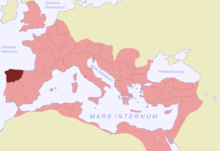Gallaecia

In ancient times and in the Middle Ages, Gallaecia was the Latin name of a landscape in the northwest of the Iberian Peninsula , which roughly encompassed present-day Galicia and some neighboring regions of Spain and northern Portugal . In the late antiquity there was a Roman province of that name. Until the end of the 4th century only the spelling Callaecia is attested.
Gallaecia in the Roman Empire
The name was derived from the presumably Celtic Callaici tribe (also Callaeci , Greek kallaikoi ), who first came to 139/136 BC. Appears in the sources; The Romans were able to fight war, defeated by them at that time, later fought by Caesar , but only finally subjugated by Emperor Augustus . As part of the provincial division made by Augustus, the Callaecia region became part of the Hispania citerior province , for which the name Tarraconensis (after the capital Tarraco , today's Tarragona ) became naturalized during the imperial period . In the south the Callaecia reached as far as the river Duero (Douro), in the east it bordered on the later Asturias . It consisted of two judicial districts, the north of Lucus Augusti (now Lugo ) and the south of Bracara Augusta (now Braga in Portugal).
Emperor Caracalla , who was actually called Antoninus, separated in the period 214-216 from the Hispania citerior or Tarraconensis a new province named after him Hispania nova citerior Antoniniana , which was located in the northwest of the peninsula and apparently included Galicia and Asturias. Their existence can only be deduced from inscriptions and their extent is not exactly known, because only a few sources are available because of their short life; at the latest in 238/241 it was reunited with the Tarraconensis .
In the period from 285 to 290 Emperor Diocletian increased the number of provinces of the Roman Empire during his administrative reform, which were now significantly smaller than the earlier ones. The territory of Hispania citerior was divided into three provinces, one of which was called Callaecia . It reached in the south to the river Duero (Douro) and in the east at least to the Esla , thus also included the west of Asturias; possibly Eastern Asturias and Cantabria also belonged to it. It is unclear whether the capital of this late antique province was Bracara Augusta or Asturica Augusta (today Astorga ).
Gallaecia under Suebi rule
The Great Migration put an end to Roman rule on the Iberian Peninsula. The Suebi , who invaded Hispania with the Alans and Vandals in September or October 409 , invaded Gallaecia and established a kingdom there with the capital Braga. This empire was later also called the Galician Empire . Part of Gallaecia was initially occupied by the Vandals, who withdrew after fighting with the Suebi. The Suebi nominally recognized the sovereignty of the Western Roman emperor and were supported by Roman troops in the fight against the Vandals. From 429, after consolidating their rule in Galicia, they were able to expand their sphere of influence.
The chronicle of the local bishop Hydatius von Aquae Flaviae , which was written around 468, provides information about the Suebzeit . Even after the destruction of the Suebian Empire and the incorporation of its territory into the Visigoth Empire in 585, the term Gallaecia remained in use.
literature
Roman times
- Patrick Le Roux: L'armée romaine et l'organization des provinces ibériques d'Auguste à l'invasion de 409 . Boccard, Paris 1982, ISBN 2-7018-0002-1
- Claudio Sánchez-Albornoz: Divisiones tribales y administrativas del solar del reino de Asturias en la época romana . In: Claudio Sánchez-Albornoz: Orígenes de la nación española , vol. 1, Instituto de Estudios Asturianos, Oviedo 1972, pp. 51-100.
- Alain Tranoy: La Galice romaine. Research on the north-east of the peninsule ibérique dans l'Antiquité . Boccard, Paris 1981
Early middle ages
- Roger Collins : Early Medieval Spain. Unity in Diversity 400-1000 . Macmillan, London 1983, ISBN 0-333-26282-4
- Erwin Koller, Hugo Laitenberger (Ed.): Suevos - Swabia. The Kingdom of the Suebi on the Iberian Peninsula (411–585) . Narr, Tübingen 1998, ISBN 3-8233-5091-9
Remarks
- ↑ At the time of the separation and the presumed extent of the new province, see Patrick Le Roux: L'armée romaine et l'organization des provinces ibériques d'Auguste à l'invasion de 409 , Paris 1982, pp. 368-370. On the measure of Caracallas, see Alain Tranoy: La Galice romaine. Recherches sur le nord-ouest de la péninsule ibérique dans l'Antiquité , Paris 1981, pp. 389-392.
- ↑ Ángel Montenegro Duque, José María Blázquez Martínez: Historia de España , ed. Ramón Menéndez Pidal, José María Jover Zamora, Vol. 2: España romana , Madrid 1982, pp. 260f .; Claudio Sánchez-Albornoz: Divisiones tribales y administrativas del solar del reino de Asturias en la época romana . In: Claudio Sánchez-Albornoz: Orígenes de la nación española , Vol. 1, Oviedo 1972, pp. 99f. (and map).
- ↑ For the research discussion on this question, see Rudolf Haensch: Capita provinciarum , Mainz 1997, pp. 173f .; Alain Tranoy: La Galice romaine. Recherches sur le nord-ouest de la péninsule ibérique dans l'Antiquité , Paris 1981, p. 404.
- ^ For example, Gregor von Tours , Historiae VI 43: regnum Galliciensim suscepit .
- ↑ See on these events Alain Tranoy: La Galice romaine. Recherches sur le nord-ouest de la péninsule ibérique dans l'Antiquité , Paris 1981, pp. 436-447.
